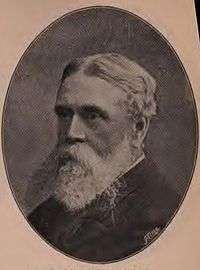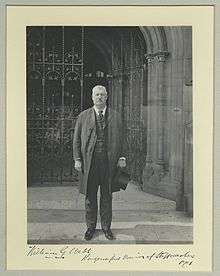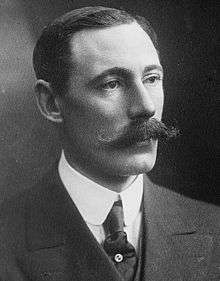Kingswinford (UK Parliament constituency)
Kingswinford was a parliamentary constituency centred on the town of Kingswinford in Staffordshire. It returned one Member of Parliament to the House of Commons of the Parliament of the United Kingdom.
| Kingswinford | |
|---|---|
| Former constituency for the House of Commons | |
| 1885–1950 | |
| Number of members | one |
| Replaced by | Brierley Hill and Rowley Regis and Tipton |
| Created from | West Staffordshire |
The constituency was created for the 1885 general election, and abolished for the 1950 general election, when the new Brierley Hill constituency took over much of the area, Brierley Hill Urban District having already absorbed much of Kingswinford Rural District more than a decade earlier.
Boundaries
1885-1918
The Sessional Divisions of Bilston, Kingswinford, Wordsley, Rowley Regis, Sedgley, Willenhall, Wolverhampton and the municipal borough of Wolverhampton.[1]
1918-1950
The Urban Districts of Amblecote, Brierley Hill, Quarry Bank, and Rowley Regis, and the Rural District of Kingswinford.
Members of Parliament
| Election | Member | Party | |
|---|---|---|---|
| 1885 | Alexander Staveley Hill | Conservative | |
| 1900 | William George Webb | Conservative | |
| 1905 by-election | Henry Staveley-Hill | Conservative | |
| 1918 | Charles Sitch | Labour | |
| 1931 | Alan Todd | Conservative | |
| 1935 | Arthur Henderson | Labour | |
| 1950 | constituency abolished: see Brierley Hill | ||
Contributions in Parliament by Kingswinford MPs
Mr Alexander Hill November 24, 1885 - October 1, 1900
Mr William Webb October 1, 1900-June 14, 1905
Mr Charles Sitch December 14, 1918-October 27, 1931
Election results 1885-1918
| Decades: |
Elections in the 1880s

| Party | Candidate | Votes | % | ± | |
|---|---|---|---|---|---|
| Conservative | Alexander Staveley Hill | 5,161 | 53.3 | N/A | |
| Liberal | George King Harrison | 4,530 | 46.7 | N/A | |
| Majority | 631 | 6.6 | N/A | ||
| Turnout | 9,691 | 79.0 | N/A | ||
| Registered electors | 12,272 | ||||
| Conservative win (new seat) | |||||
| Party | Candidate | Votes | % | ± | |
|---|---|---|---|---|---|
| Conservative | Alexander Staveley Hill | Unopposed | |||
| Conservative hold | |||||
Elections in the 1890s
| Party | Candidate | Votes | % | ± | |
|---|---|---|---|---|---|
| Conservative | Alexander Staveley Hill | 5,371 | 58.6 | N/A | |
| Liberal | Thomas Parker | 3,800 | 41.4 | N/A | |
| Majority | 1,571 | 17.2 | N/A | ||
| Turnout | 9,171 | 78.0 | N/A | ||
| Registered electors | 11,757 | ||||
| Conservative hold | Swing | N/A | |||
| Party | Candidate | Votes | % | ± | |
|---|---|---|---|---|---|
| Conservative | Alexander Staveley Hill | Unopposed | |||
| Conservative hold | |||||
Elections in the 1900s

| Party | Candidate | Votes | % | ± | |
|---|---|---|---|---|---|
| Conservative | William George Webb | Unopposed | |||
| Conservative hold | |||||
| Party | Candidate | Votes | % | ± | |
|---|---|---|---|---|---|
| Conservative | Henry Staveley-Hill | 5,490 | 52.9 | N/A | |
| Liberal | Edward Marten Dunne | 4,887 | 47.1 | N/A | |
| Majority | 603 | 5.8 | N/A | ||
| Turnout | 10,377 | 78.0 | N/A | ||
| Registered electors | 13,301 | ||||
| Conservative hold | Swing | N/A | |||

| Party | Candidate | Votes | % | ± | |
|---|---|---|---|---|---|
| Conservative | Henry Staveley-Hill | 6,311 | 53.6 | N/A | |
| Liberal | Frederick Guest | 5,470 | 46.4 | N/A | |
| Majority | 841 | 7.2 | N/A | ||
| Turnout | 11,781 | 84.7 | N/A | ||
| Registered electors | 13,912 | ||||
| Conservative hold | Swing | N/A | |||
Elections in the 1910s
| Party | Candidate | Votes | % | ± | |
|---|---|---|---|---|---|
| Conservative | Henry Staveley-Hill | 7,267 | 58.2 | +4.6 | |
| Liberal | Frederick L. Coysh | 5,226 | 41.8 | -4.6 | |
| Majority | 2,041 | 16.4 | +9.2 | ||
| Turnout | 88.8 | +4.1 | |||
| Conservative hold | Swing | +4.6 | |||
| Party | Candidate | Votes | % | ± | |
|---|---|---|---|---|---|
| Conservative | Henry Staveley-Hill | Unopposed | |||
| Conservative hold | |||||
General Election 1914/15:
Another General Election was required to take place before the end of 1915. The political parties had been making preparations for an election to take place and by the July 1914, the following candidates had been selected;
- Unionist: Henry Staveley-Hill
- Liberal: Geoffrey Mander[7]
Election results 1918-1949
| Decades: |
Elections in the 1910s
| Party | Candidate | Votes | % | ± | |
|---|---|---|---|---|---|
| Labour | Charles Sitch | 10,397 | 47.6 | N/A | |
| Unionist | Arthur Edward Beck | 7,509 | 34.4 | N/A | |
| Liberal | Henry Ernest Brown | 3,943 | 18.0 | N/A | |
| Majority | 2,888 | 13.2 | N/A | ||
| Turnout | 21,849 | 57.6 | N/A | ||
| Registered electors | 37,924 | ||||
| Labour gain from Unionist | Swing | N/A | |||
Elections in the 1920s
| Party | Candidate | Votes | % | ± | |
|---|---|---|---|---|---|
| Labour | Charles Sitch | 15,232 | 51.6 | +4.0 | |
| National Liberal | Gilbert Hugh Beyfus | 14,313 | 48.4 | N/A | |
| Majority | 919 | 3.2 | −10.0 | ||
| Turnout | 29,545 | 75.2 | +17.6 | ||
| Registered electors | 39,306 | ||||
| Labour hold | Swing | N/A | |||
| Party | Candidate | Votes | % | ± | |
|---|---|---|---|---|---|
| Labour | Charles Sitch | 15,174 | 49.5 | −2.1 | |
| Unionist | William Harcourt-Webb | 10,862 | 35.4 | N/A | |
| Liberal | Cecil Patrick Blackwell | 4,633 | 15.1 | −33.3 | |
| Majority | 4,312 | 14.1 | +10.9 | ||
| Turnout | 30,669 | 76.6 | +1.4 | ||
| Registered electors | 40,045 | ||||
| Labour hold | Swing | +15.6 | |||
| Party | Candidate | Votes | % | ± | |
|---|---|---|---|---|---|
| Labour | Charles Sitch | 17,235 | 51.5 | +2.0 | |
| Unionist | William Harcourt-Webb | 16,208 | 48.5 | +13.1 | |
| Majority | 1,027 | 3.0 | −11.1 | ||
| Turnout | 33,443 | 82.6 | +6.0 | ||
| Registered electors | 40,470 | ||||
| Labour hold | Swing | −5.6 | |||
| Party | Candidate | Votes | % | ± | |
|---|---|---|---|---|---|
| Labour | Charles Sitch | 22,479 | 53.2 | +1.7 | |
| Unionist | Sidney Garcke | 12,151 | 28.7 | −19.8 | |
| Liberal | Alfred William Bowkett | 7,639 | 18.1 | N/A | |
| Majority | 10,328 | 24.5 | +21.5 | ||
| Turnout | 42,269 | 79.0 | −3.6 | ||
| Registered electors | 53,530 | ||||
| Labour hold | Swing | +10.8 | |||
Elections in the 1930s
| Party | Candidate | Votes | % | ± | |
|---|---|---|---|---|---|
| Conservative | Alan Todd | 21,934 | 52.94 | +24.2 | |
| Labour | Charles Sitch | 19,495 | 47.06 | -6.2 | |
| Majority | 2,439 | 5.89 | 30.4 | ||
| Turnout | 75.14 | ||||
| Conservative gain from Labour | Swing | +15.2 | |||
| Party | Candidate | Votes | % | ± | |
|---|---|---|---|---|---|
| Labour | Arthur Henderson | 20,925 | 50.02 | +2.9 | |
| Conservative | Alan Todd | 20,909 | 49.98 | -2.9 | |
| Majority | 16 | 0.04 | 5.8 | ||
| Turnout | 71.52 | -3.6 | |||
| Labour gain from Conservative | Swing | +2.9 | |||
Elections in the 1940s
| Party | Candidate | Votes | % | ± | |
|---|---|---|---|---|---|
| Labour | Arthur Henderson | 34,307 | 69.16 | +16.2 | |
| Conservative | E.G. Taylor | 15,297 | 30.84 | -16.2 | |
| Majority | 19,010 | 38.32 | +32.4 | ||
| Turnout | 73.71 | +2.2 | |||
| Labour hold | Swing | +16.2 | |||
References
- Debrett's House of Commons & Judicial Bench, 1886
- British Parliamentary Election Results 1885-1918, FWS Craig
- The Liberal Year Book, 1907
- Debrett's House of Commons & Judicial Bench, 1896
- Debrett's House of Commons & Judicial Bench, 1901
- Debrett's House of Commons & Judicial Bench, 1916
- Evening Despatch, West Midlands, 25 May 1914
- British Parliamentary Election Results 1918-1949, FWS Craig (1983). Chichester: Parliamentary Research Services. ISBN 0-900178-06-X.
- Debrett's House of Commons and the Judicial Bench
- The Liberal Year Book, 1926